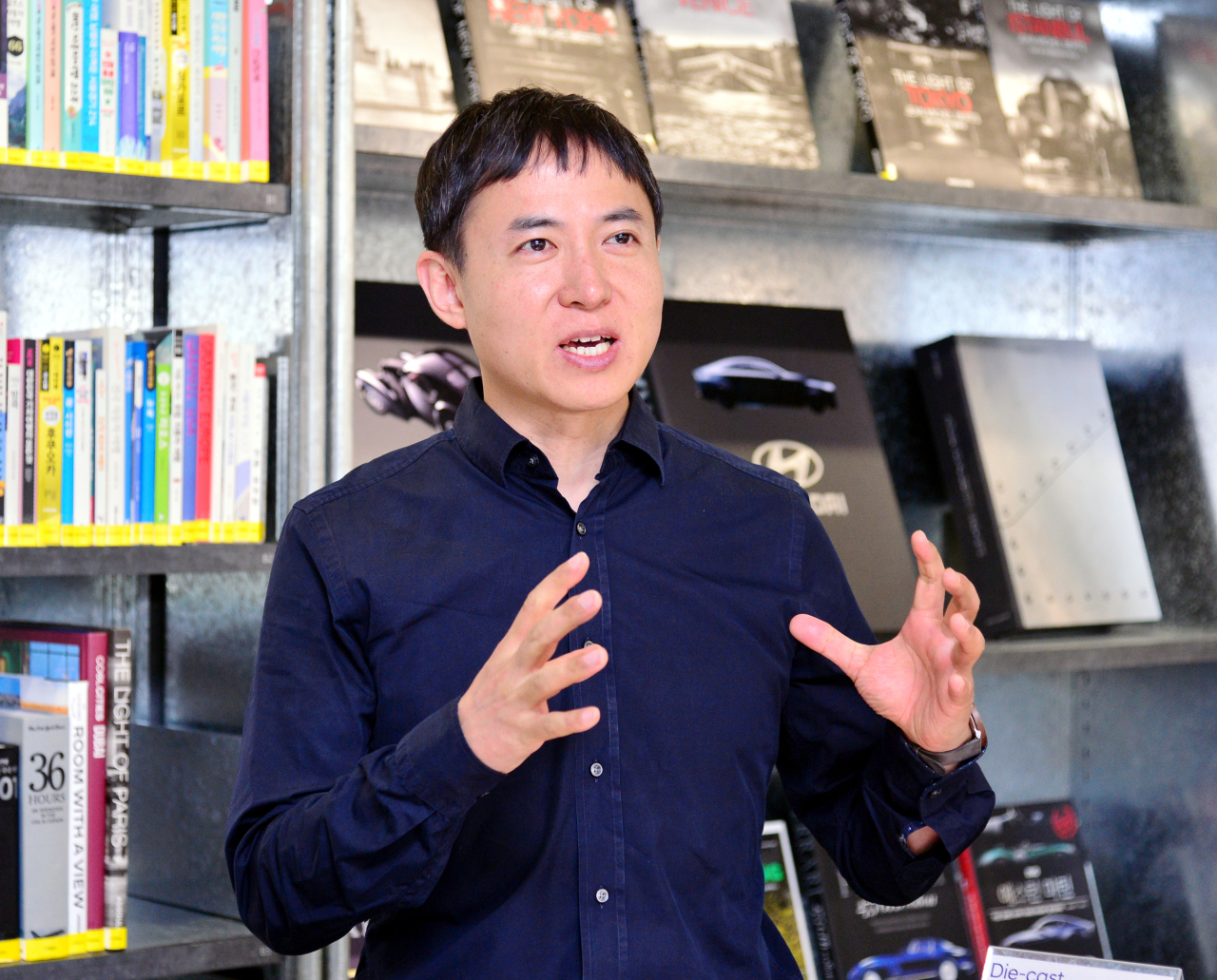The occupation of curator is not one that most people are familiar with -- many think it’s all about organizing and planning exhibitions.
Korean curator Lee Dae-hyung is someone who pushes the boundary of what a curator can do. Having started his career as an exhibition curator, Lee has contributed to many local art fairs, has done art consulting for corporations, was the director of the Korean Pavilion at the Venice Biennale in 2017 and is now the team leader of Hyundai Motor’s creative initiative Artlab.
The Korea Herald met Lee at a library within Hyundai Motorstudio in Gangnam-gu, Seoul, May 15, just two days after he returned from the Venice Biennale.
There, Lee shared his thoughts on the contemporary art scene, along with various projects launched by his team at Hyundai Motor.
“I came to these thoughts when I was preparing for the Venice Biennale in 2017. Let’s suppose we are riding on a train and looking out the window. The landscape you see is changing very quickly, and that’s how the world is changing now. The landscape you just saw became part of the past immediately,” Lee said.
“The issues that we are confronting now will quickly become issues of the past. We, thus, have to be able to predict what happens in the future, and I believe that art can help us do that,” Lee said.
Everything changes quickly in this era shaped by rapidly developing technology, and so does the art scene. The conventional exhibition venue is becoming more and more of a zero-sum game, Lee said.
“How many people can actually have their works exhibited at prestigious venues like the Museum of Modern and Contemporary Art here and the Venice Biennale? The market is very limited,” Lee said.
But there are much more diverse activities going on outside of the museum space, chances to invite other industries and fields into the realm of fine art.
According to Lee, private agents in the art scene are more aggressive and keener on finding new artists and new opportunities, compared with the more conservative public sector.
Lee, for instance, saw Christies’ upcoming forum, titled “2019 Art Tech Summit: The A.I. Revolution,” as one of the private sector’s efforts to expand its influence.
Hyundai Motor joins the Christies’ event in New York on June 25 to discuss the intersection of technology, art and the art market. It will bring together experts from different fields, such as Google, Pace Gallery, MIT Technology Review, the Metropolitan Museum of Art and the New Museum.
“Technologies are getting used more and more in the creative industry, and you become old school if you don’t keep pace,” Lee said.
The newly emerging market presents challenges but opportunities too. Hyundai Motor’s Artlab also started as an attempt to pioneer this newly emerging market.
Artlab is not a donor, though it offers financial support to museums like the MMCA, Tate and the Los Angeles County Museum of Art. It is not a curatorial agent either, as it seldom gets involved in the actual curation process.
It is more of a platform provider, according to Lee. Artlab designs platforms for agents from different areas, who will come together to discuss what to present to the public.
Artlab’s collaborative partnership with Bloomberg resulted in one of its platforms, “Art + Technology,” which introduces various collaborative agents in the art scene.
“Art + Technology” is an online video series designed to introduce contemporary artists who make extensive use of cutting-edge technologies -- AI, 3D printing, drones, projection mapping, augmented reality, biochemistry and so on. The three-year project will introduce numerous contemporary artists over 108 episodes.
Lee added, however, that Artlab’s most important art platform is Hyundai Tate Research Centre: Transnational, a research initiative dedicated to exploring multiple art histories from different parts of the world, particularly those outside Europe and North America.
“Research is a fundamental aspect of the fine arts sector. … The six-year project started off as a research-driven platform,” Lee said, adding that he hoped it would contribute to a better research environment where people would try to introduce more stories from marginalized nations and promote lesser-known yet talented artists to the public.
“I don’t think a company can change the world. But I think a company can support people who can do that, people who try new things and lead the way into the future.”
Lee is also making efforts to build platforms dedicated to nurturing young curators.
The Hyundai Blue Prize is an annual award to support contemporary Chinese art curators, which Artlab started in 2017. Lee also initiated Research Fellow 2018 Korea 10X10, a local program hosted by the Korean Culture and Information Service, which supports exchanges between curators from here and abroad. The MMCA is going to join as a contributing partner this year.
“Many people say a network for curators is a valuable asset. A network is no use if you monopolize it,” Lee said.
Lee fancies the idea of connecting people because much more diverse discourses can come out when many players take part.
“I used to want to become a star curator, but now I want to focus on building platforms and environments where many people can meet each other. It is just wonderful to see them meeting each other and sharing stories,” Lee added.
Lee, who is perhaps one of the busiest curators in Korea, says he would like to spend his daily life surrounded by stacks of books and engaging in discussions with others.
“The time I spent preparing the Korean Pavilion was the most taxing yet also the happiest time in my life. I really liked life in an office full of books. I would read and take a nap on the sofa if I was tired. Then I would get back to a meeting with the team members and again get back to reading for ideas,” Lee said.
By Shim Woo-hyun (
ws@heraldcorp.com)








![[Today’s K-pop] Blackpink’s Jennie, Lisa invited to Coachella as solo acts](http://res.heraldm.com/phpwas/restmb_idxmake.php?idx=644&simg=/content/image/2024/11/21/20241121050099_0.jpg)